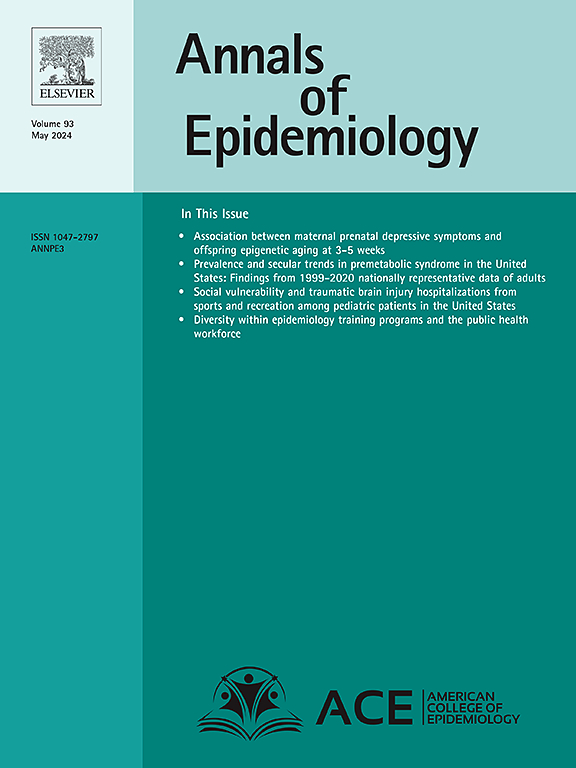在癌症幸存者中观察到更高的长COVID患病率:来自美国全国调查的见解。
IF 3
3区 医学
Q1 PUBLIC, ENVIRONMENTAL & OCCUPATIONAL HEALTH
引用次数: 0
摘要
背景:癌症和癌症治疗会削弱人体的免疫系统,使癌症患者特别容易感染COVID-19。虽然有证据表明,癌症患者在感染COVID-19后出现严重后果的风险可能会增加,但缺乏基于人群的研究,比较癌症幸存者和非癌症个体之间的长期COVID患病率。方法:我们利用2022年行为风险因素监测系统(BRFSS)的数据,分析了120,658名COVID-19检测呈阳性的美国成年人样本。长期COVID被定义为COVID-19症状持续三个月或更长时间。比较了癌症幸存者和非癌症个体之间长冠状病毒的加权患病率。计算粗比值比(or)和校正比值比(or), 95%置信区间(ci)。采用多重归算方法解决COVID-19疫苗接种数据缺失问题。结果:在17362例COVID-19检测呈阳性的癌症幸存者中,4009例报告长COVID(加权患病率= 24.0%),而非癌症个体的加权患病率为21.6% (p < 0.001)。在控制协变量并考虑复杂抽样设计后,调整OR为1.17 (95% CI = 1.06-1.30, p = 0.002)。在45岁以下的参与者中,癌症幸存者的长COVID患病率明显高于非癌症个体(32.1%对21.3%,p < 0.001),调整后OR为1.33 (95% CI = 1.07-1.66, p = 0.012)。在45岁及以上的参与者中,患病率差异无统计学意义(22.7% vs. 21.9%, p = 0.324),校正OR为1.14 (95% CI = 1.02-1.27, p = 0.024)。关于COVID-19疫苗接种与长COVID的关联,四次或更多剂量与癌症幸存者中长COVID的几率显著降低相关(调整后or =0.55, 95%CI = 0.34-0.88, p = 0.013)。结论:观察到癌症幸存者发展为长COVID的几率更高,特别是年轻的幸存者。COVID-19疫苗接种与长冠状病毒的关联在癌症幸存者和非癌症个体之间有所不同,癌症幸存者需要更多剂量才能显著降低长冠状病毒的几率。本文章由计算机程序翻译,如有差异,请以英文原文为准。
Higher prevalence of long COVID observed in cancer survivors: Insights from a US nationwide survey
Background
Cancer and cancer treatments can weaken the body's immune system, making cancer patients particularly vulnerable to COVID-19. While evidence suggests that cancer patients may be at increased risk for severe outcomes after COVID-19 infection, there is a lack of population-based studies comparing long COVID prevalence between cancer survivors and non-cancer individuals.
Methods
We utilized data from the 2022 Behavioral Risk Factor Surveillance System (BRFSS), analyzing a sample of 120,658 U.S. adults who had tested positive for COVID-19. Long COVID was defined as the presence of COVID-19 symptoms lasting three months or longer. The weighted prevalence of long COVID was compared between cancer survivors and non-cancer individuals. Crude and adjusted odds ratios (ORs) with 95 % confidence intervals (CIs) were calculated. Multiple imputation was employed to address missing data on COVID-19 vaccination.
Results
Among 17,362 cancer survivors who tested positive for COVID-19, 4009 reported having long COVID (weighted prevalence = 24.0 %), compared to a weighted prevalence of 21.6 % in non-cancer individuals (p < 0.001). After controlling for covariates and accounting for the complex sampling design, the adjusted OR was 1.17 (95 % CI = 1.06–1.30, p = 0.002). In participants under 45 years old, cancer survivors had a notably higher prevalence of long COVID compared to non-cancer individuals (32.1 % vs. 21.3 %, p < 0.001), with an adjusted OR of 1.33 (95 % CI = 1.07–1.66, p = 0.012). In participants aged 45 and above, the prevalence difference was not significant (22.7 % vs. 21.9 %, p = 0.324), with an adjusted OR of 1.14 (95 % CI = 1.02–1.27, p = 0.024). Regarding the association of COVID-19 vaccination with long COVID, four or more doses were linked to a significant reduced odds of long COVID among cancer survivors (adjusted OR=0.55, 95 %CI = 0.34–0.88, p = 0.013).
Conclusions
Cancer survivors are observed to have higher odds of developing long COVID, particularly younger survivors. The association of COVID-19 vaccination with long COVID varies between cancer survivors and non-cancer individuals, with cancer survivors requiring more doses to achieve significant reduction in the odds of long COVID.
求助全文
通过发布文献求助,成功后即可免费获取论文全文。
去求助
来源期刊

Annals of Epidemiology
医学-公共卫生、环境卫生与职业卫生
CiteScore
7.40
自引率
1.80%
发文量
207
审稿时长
59 days
期刊介绍:
The journal emphasizes the application of epidemiologic methods to issues that affect the distribution and determinants of human illness in diverse contexts. Its primary focus is on chronic and acute conditions of diverse etiologies and of major importance to clinical medicine, public health, and health care delivery.
 求助内容:
求助内容: 应助结果提醒方式:
应助结果提醒方式:


